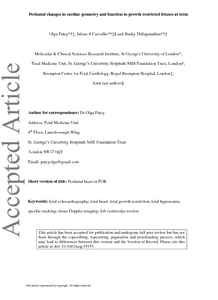Patey, O; Carvalho, JS; Thilaganathan, B
(2019)
Perinatal changes in cardiac geometry and function in growth restricted fetuses at term.
Ultrasound in Obstetrics and Gynecology, 53 (5).
pp. 655-662.
ISSN 1469-0705
https://doi.org/10.1002/uog.19193
SGUL Authors: Carvalho, Julene
![[img]](https://openaccess.sgul.ac.uk/110045/1.hassmallThumbnailVersion/Patey_et_al-2018-UOG_Accepted%202018.08.06.pdf)  Preview |
|
PDF
Accepted Version
Available under License ["licenses_description_publisher" not defined].
Download (1MB)
| Preview
|
Abstract
Objective
To evaluate the effect of fetal growth restriction (FGR) at term on fetal and neonatal cardiac geometry and function.
Methods
Prospective study of 87 pregnant women delivering, comprising of 54 normally grown and 33 FGR pregnancies at term. Fetal and neonatal conventional, spectral tissue Doppler, and 2D speckle tracking imaging echoes were performed few days before and within hours of birth.
Results
Compared to normal pregnancy, FGR fetuses exhibited more globular ventricular geometry, poorer myocardial deformation and cardiac function (LV sphericity index [SI]: 0.49 vs 0.54, RV SI: 0.54 vs 0.60, LV torsion 3.0deg/cm vs 1.6deg/cm, LV isovolumetric contraction time normalised by cardiac cycle length: 104ms vs 121ms, intra‐ventricular septum E’/A’: 0.71 vs 0.60, p<0.001 for all). The poorest adverse perinatal outcomes occurred in FGR fetuses with most impaired cardiac functional indices. When compared to normal newborns, FGR neonates revealed persistent alteration in cardiac parameters (LV SI: 0.50 vs 0.53, RV SI: 0.44 vs 0.54, LV torsion 1.4deg/cm vs 1.1deg/cm, LV myocardial performance index [MPI’] 0.42 vs 0.52, p<0.001 for all). Paired comparison of fetal and neonatal cardiac indices in FGR demonstrated that birth resulted in significant improvement in some, but not all cardiac indices (RV SI: 0.60 vs 0.54, RV MPI’: 0.49 vs 0.39, p<0.001 for all).
Conclusions
Compared to normal pregnancy, FGR fetuses and neonates at term exhibit altered cardiac indices indicative of myocardial impairment that reflect adaptation to placental hypoxemia and alterations in hemodynamic load around the time of birth. Elucidating potential mechanisms that contribute to the alterations in perinatal cardiac adaptation in FGR could improve the management and evolve better therapeutic strategies to reduce the risk of adverse pregnancy outcome.
| Item Type: |
Article
|
| Additional Information: |
This is the peer reviewed version of the following article: Patey, O. , Carvalho, J. S. and Thilaganathan, B. (2019), Perinatal changes in cardiac geometry and function in growth‐restricted fetuses at term. Ultrasound Obstet Gynecol, 53: 655-662, which has been published in final form at https://doi.org/10.1002/uog.19193. This article may be used for non-commercial purposes in accordance with Wiley Terms and Conditions for Use of Self-Archived Versions. |
| Keywords: |
Obstetrics & Reproductive Medicine, 1114 Paediatrics And Reproductive Medicine |
| SGUL Research Institute / Research Centre: |
Academic Structure > Molecular and Clinical Sciences Research Institute (MCS) |
| Journal or Publication Title: |
Ultrasound in Obstetrics and Gynecology |
| ISSN: |
1469-0705 |
| Publisher License: |
Publisher's own licence |
| Projects: |
| Project ID | Funder | Funder ID |
|---|
| UNSPECIFIED | Children's Heart Unit Fund | UNSPECIFIED | | 14EDI01 | SPARKS Charity | UNSPECIFIED | | UNSPECIFIED | Royal Brompton and Harefield Hospital Charity | UNSPECIFIED |
|
| Dates: |
| Date |
Event |
| 2019-05-03 |
Published |
| 2018-04-09 |
Published Online |
| 2018-07-23 |
Accepted |
|
| URI: |
https://openaccess.sgul.ac.uk/id/eprint/110045 |
| Publisher's version: |
https://doi.org/10.1002/uog.19193 |
Statistics
Item downloaded times since 14 Aug 2018.
Actions (login required)
 |
Edit Item |


